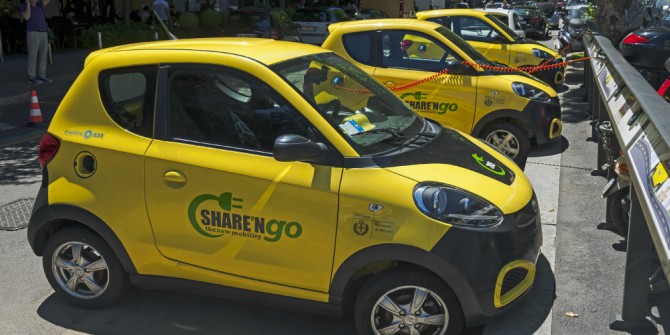
Is car ownership going to die? The definite answer in the short term is no. The longer answer is that we are going to see a big shift in car ownership in the next 12 years. Interestingly, it’s an equation with several variables. It’s all in the economics, and the pieces are already on the table.
New technologies, new financing models
Technological development is driving both the move from diesel and gasoline-fuelled to electric cars, and the move from human drivers to self-driving (or autonomous) vehicles. This results in auto companies moving away from making internal combustion engines (ICEs) and into manufacturing all-electric engines.
Last year offered several examples of this trend. In May, Volvo announced it would completely stop making diesel engines by 2019. Mercedes-Benz announced electrification of all commercial vans. GM said it would ditch all internal combustion engines and move to become fully electric. Volkswagen announced it will offer an electric version of all its models by 2030. Jaguar Land Rover announced that by 2020 it would build only hybrid and electric vehicles. Maserati and Rolls-Royce will skip hybrid and go fully electric. Ferrari introduced its first EV in the last few days of December, and the list goes on.
Some of these companies have also started testing and introducing new financing models that disrupt current models of ownership and leasing. Two of those companies are Volvo and Ford. Volvo is looking to diversify its pricing model with a subscription option. You will not own a Volvo, you will “subscribe” to it, like you subscribe to the gym or to Netflix, no commitment. It will include the car you want, maintenance and insurance. Ford is basically doing the same through its subsidiary, Canvas.
The role of government
Governments are increasingly more interested in allocating investment dollars towards shared mobility and green space. Governments and cities are actively pushing to reduce the use of private vehicles in cities and highways, with adoption of different shared mobility solutions. In conjunction, they are encouraging the use of electric vehicles through rebates and tax credits. Various cities in the Los Angeles Metropolitan area are actively looking to implement different ways to reduce traffic congestion such as van pooling which encourages individuals to stop using their cars for commuting. Culver City, for example, is considering a van pooling service to shuttle workers to and from bus and train stations.
Sacramento, California has been chosen as the “first green city” in the U.S. by Volkswagen’s subsidiary Electrify America, a title which comes with $44 million in investments. Electrify America aims to invest a total of $800 million in California and another $1.2 billion in the rest of the U.S. to build zero-emissions transportation solutions and infrastructure nationwide.
My employer, Envoy Technologies, a Los Angeles-based company founded by Israelis Ori Sagie and Aric Ohana, provides the real estate industry with exclusive electric vehicles for their communities and has won a $1.5 million grant from the California Energy Commission to deploy 60 electric shared vehicles at 30 locations in Sacramento and the San Francisco Bay Area. The vehicles will be used exclusively by low-income communities, enabling them to both make money as part of the “gig economy” (Uber, Lyft PostMates, etc), and to possibly get rid of their old vehicles, which often incur high associated costs, while still having cars available to them at their own parking garage.
Studies show a trend
Baby boomers who want or need to work after retirement find themselves driving for gig economy companies like Uber and Lyft. A 2015 study by Uber found that nearly a quarter of its drivers were older than 50. Millennials have also helped the reduction in car ownership. Putting aside economic factors like low wages in the labour market, high rent, and the recession, millennials grew up in the years when car sharing and ride hailing have become common, so they feel more comfortable not owning a car.
A 2017 study by RethinkX, a technology think tank, claims there will be a mass shift in vehicle ownership approximately a decade after self-driving cars are legalised for public use. At that point, annual use of ride-hailing services will cost approximately $3,400 a year, while car ownership will cost $9,000 a year. The $5,600 gap might be the tipping point for changing the paradigm of car ownership for many millennials who have used the Uber Pool service since they were young. The study also shows that Transportation as a Service (TaaS) will provide 95 per cent of the passenger miles traveled within 10 years of the widespread regulatory approval of self-driving cars. By 2030, self-owned internal combustion engine cars will represent 40 per cent of the cars in the U.S. vehicle fleet, but they will provide just 5 per cent of passenger miles.
Transportation as a Service
The day when we will not own a car is near. We are already starting to see pockets of “ownership-free” communities like this community near Boston that is about to be the first community to get access to the Optimus Ride fleet of self-driving cars, providing them with on-site transportation and connecting them to mass transit. Optimus Ride recently raised an $18 million Series A round from Greycroft Partners, Emerson Collective, Fraser McCombs Capital and the current director of MIT Media Lab, Joi Ito.
It’s like air travel. Do we care whether we fly with a Boeing or an AirBus? We are approaching a time when we won’t care what car brand drives us, because eventually most of it will be autonomous. Car manufacturers realized this too, they understand self consolidation is coming and we will all be moving with the help of car fleets owned by several companies. One of the companies who understood it first is Uber, which bought 24,000 Volvos that will become the Uber autonomous fleet.
Venture money pouring
The Wall Street Journal reported in 2016 that Uber has raised $3.5 billion from a Saudi fund. In May 2016, Volkswagen invested $300 million in the Israeli GETT, which develops a ride hailing app. A year later, GETT is reportedly looking to raise an extra $700 million to expand. Meanwhile, Grab, another ride hail company that operates in Southeast Asia, has secured $2 billion from Didi Chuxing and Softbank.
No matter whether it’ll be parked in our garage or endlessly driving the streets looking for the next pick up, it seems that vehicle usership will be the new ownership.
♣♣♣
Notes:
- The post gives the views of its authors, not the position of LSE Business Review or the London School of Economics.
- Featured image credit: Shared electric cars at Piazza Duca d’Aosta, Milan, by Daniel Case, own work, under a CC BY-SA 3.0 licence, via Wikimedia Commons
- When you leave a comment, you’re agreeing to our Comment Policy.
 Niv Calderon is a business and marketing strategist. He runs the investor relations and community departments for Envoy Technologies Inc, a Los Angeles-based on demand electric vehicles startup company. He is also a tech blogger and the founder of Wearable Valley, an online community for Internet-of-Things enthusiasts. (@nivcalderon)
Niv Calderon is a business and marketing strategist. He runs the investor relations and community departments for Envoy Technologies Inc, a Los Angeles-based on demand electric vehicles startup company. He is also a tech blogger and the founder of Wearable Valley, an online community for Internet-of-Things enthusiasts. (@nivcalderon)






This is an overstated article. Car ownership is very unlikely to decline much over the next twelve years, certainly not on a global scale. Forms of ownership may become more diverse, but finance options which allow people stop short of buying the vehicle have been around for decades. We may be able to persuade people to make less use of their car through road pricing and large scale investment in good public transport systems in cities. But until that happens, our deep seated attachment to the car and car ownership will remain a powerful influence on consumer choices.
Ian,
Thanks for the comment.
Even though I respect your opinion, research, and numbers (sales, startup companies, car sharing programs) are starting to show a growing trend. And whether it happens in 12 or 15 years, it is where people are going. Moreover, I suspect your claim of “our deep-seated attachment to the car” is both a generational claim and most likely connected to your economic ability to own a car. Thank you for taking the time to read and comment on my article.
Hi Niv,
Thanks for the article. You speak of a growing trend of reduced vehicle ownership backed by research/numbers yet provide no such data in this article? Offering an arbitrary number of 12 years without a path of how we arrive there lends little credibility to the rate of change of vehicle ownership. I don’t refute that this shifting trend exists, it would be useful though if you can provide some evidence of this. Thanks
While there is low brand awareness of the growing range of P2P car sharing platforms, a survey of users on DriveTribe suggests 71% of respondents would be receptive to a P2P model that enables cost effective, flexible access to transportation. 30% also suggested they would be prepared to rent their own vehicles in order to generate an income or fund their vehicle ownership. I appreciate that the survey may not be academically robust to the standards of the LSE, but nevertheless it is an interesting snapshot that suggests the proportion of buy-side and sell-side interest is apparently (latently) available. A few years back no one had heard of Uber or Lyft, yet now they’re mega brands in certain parts of the world. Perhaps that will be the same for P2P sharing platforms like Drivvy, Getaround, Turo and others. With manufacturers like Chinese brand Lynk & Co launching app-driven mobility subscription services, it looks likely that p2p shared mobility (in someway analogous to p2p room rental services like Air BnB) could well be a pre-cursor to broader industry-led on-demand transportation services. Certainly it’s an issue that has captured the interest and concerns of car manufacturers, dealers and car rental companies.